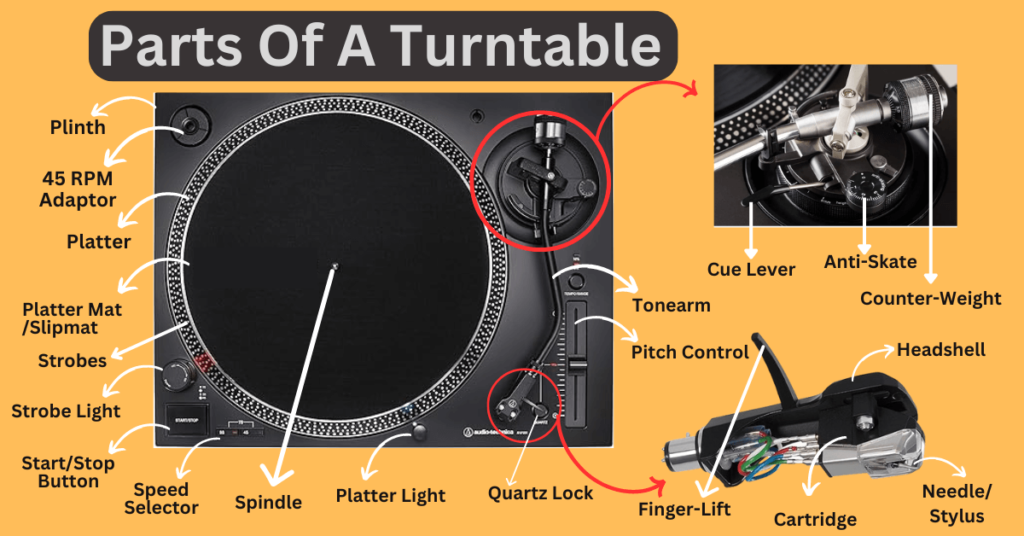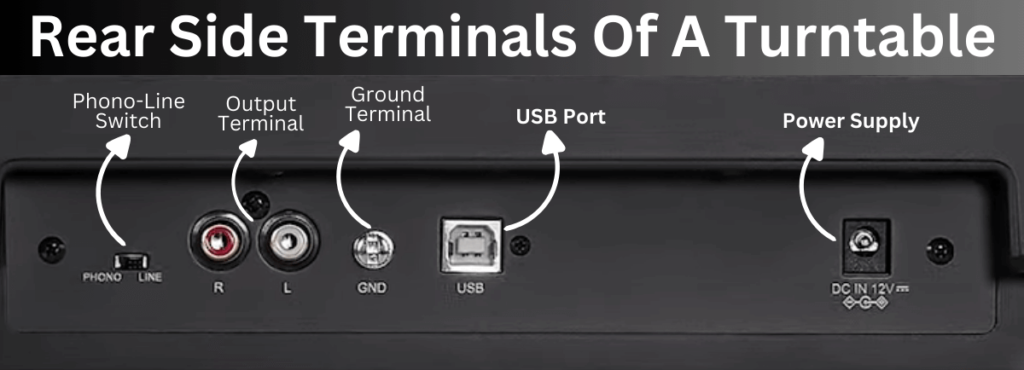Parts Of A Record Player: The Only Guide You Will Ever Need
The record players are typical audio devices that contain multiple components and each works in sync with each other.
The terms record player and turntable are used interchangeably in the article. So, don’t get confused.
As an avid record collector, I inherited this hobby from my parents. While growing up, I used to assist them in cleaning the record player and repairing or replacing its parts which gave me a deep understanding of how the vinyl record and turntable works.
If you are a beginner and just bought a turntable, then knowing the different parts will help you to set up and maintain the turntable for the best audio experience.
Let’s dive deep into the different parts of a record player.
Parts of a Turntable with Diagram

Plinth
The plinth is the base on which all the parts of the turntable are attached. It is a heavy platform that dampens the external and motor vibrations, which interfere with the stylus when following the grooves of the record and helps in removing the unnecessary distortion in the sound. They are usually made of metal, wood, or acrylic.
45 RPM Adaptor
It is used when you want to play a 45 rpm record or an EP. It is a small circular metal attachment that is placed in the middle of a 7-inch record so that it can be played on the standard spindle of the turntable.
Platter and Platter Mats/Slip Mats
Platter is the circular disk with the hole in the middle which rests above the plinth, made up of metal, glass or acrylic. It is the rotating surface on which record is placed for playback.
The platters are helpful in isolating the external vibration and maintaining the consistent speed of rotation to get consistent music experience.
Platter mats are thin circular sheet placed on the platter to prevent vinyl records from slipping and helps to reduce mechanical vibrations. It is usually made of felt, rubber, or cork.
Vinyl slip mats are mostly used by DJs to perform musical transitions, because it allows the record to slip on the rotating platter.
Strobes and Strobe Light
The strobes are the series of dots that are marked on the perimeter of the platter. It plays no active role in producing music from the record, but it serves as a reference for setting the correct pitch on the turntable.
The strobe light on a turntable is used to verify that the platter is spinning at the correct speed. It flashes at specific frequency on the strobes to see if the band of dots appears steady when the turntable is turned on, which means it is spinning at the accurate speed else you have to make some corrections using pitch control.
Start/Stop Button
It is used to turn the record player on and off. After placing the disc on the platter, press the start/stop button and it will start spinning and when you want to stop, press it again.
Speed Selector
The speed selector selects the speed at which the record is supposed to rotate. Mostly, there are two speed options available 33 ⅓ and 45 RPM to play LP and EP respectively. In some turntables, the 78 RPM option is present to play old shellac records.
Platter Light
This is the light that shines over the groove of the record that you place on the platter to play to clearly see where you are placing the stylus.
Spindle
The spindle is a vertical rod connected to the motor at the center of the platter, holding the record in place as it spins. The hole in the center of the vinyl record fits onto the spindle, ensuring that the record remains in place, to get the detailed playback output.
Motor
The motor is the most important component of the turntable located under the platter which is responsible for driving its rotation.
Turntables comes with two types of motors: direct drive and belt drive
In direct drive turntables, motor is directly connected to the platter and provides quick startup and high torque, and mostly used by DJs.
In belt drive turntables, motor is attached to platter with the help of rubber belt to isolate the unwanted vibrations from the motor and provides rich musical experience, preferred by audiophiles.
Pitch Control
The pitch control lever is mostly used for DJing. It is used to increase or decrease the speed of rotation of the motor allowing us to perform music transitions like beatmatching
Quartz Lock Button
It is the small button located next to the pitch control system. When the quartz lock is on, its primary function is to disable the pitch control function, you will not hear any difference in the sound when adjusting the pitch control knob.
Tonearm
The tonearm is the essential part of turntables that holds the cartridge (which contains the stylus) at one end and the counterweight at the other.
It has a tube-shaped structure, made of aluminum or carbon fiber, which comes in two shapes: Straight or S-shaped. While the record is played, the tonearm moves from the edge of the record to the center.
It is essential because it carries audio signals from the vinyl record to the rest of the system.
Counter-Weight
The counter-weight is attached at the end of the tonearm which has a circular dial to control how much pressure the needle puts on the record while playing. This is called vertical-tracking force.
Anti-Skate
The anti-skate is a small circular knob which is used to adjust the side-by-side movement of the tonearm. When the record is played, the tonearm has the natural tendency to slide toward the center of the record because of an internal pulling force.
Anti-skate is a feature that applies a small external force in the opposite direction to stop the tonearm from sliding inwards quickly. It helps prevent the needle and records from damage.
Cue-Lever
The cueing lever is a tool to gently lower the tonearm on the vinyl record at the appropriate position to prevent the stylus and record from damage.
To use it, you start spinning the record, lift the cue-lever, move the tonearm to the right spot on the record, and then lower it. When the record is finished again you lift the cue-lever, return the tonearm to its resting cradle, and stop the rotating record.
Cartridge and Stylus
The cartridge can often be considered as the ‘brain’ of the record player because it is the system of coils and magnets which converts the mechanical movements captured from the stylus into electrical signals.
The stylus also known as ‘needle’ is the part of the cartridge. As the record spins, the stylus traces the grooves of the vinyl record and picks the mechanical vibrations which then transmitted to cartridge for conversion into electrical signals.
Headshell
The headshell is the part on which the cartridge is fastened with screws. This is the component that connects the cartridge and stylus to the tonearm. Some turntables have no headshell and the cartridge is directly attached to the tonearm.
Finger Lift
The small protruding handle comes out from the headshell to easily lift the tonearm that works in tandem with cue-lever. So, first, we lift the cue lever, then use a finger-lift handle to lift the tonearm, position the stylus accurately on the record, and then lower the cue lever.
It prevents you to directly touch the sensitive parts like stylus.
Adjustment Legs
These are the four rotating legs on which the entire turntable platform sits. By rotating it we adjust the level of the turntable, if it is is not levelled evenly, you will get distortion in the sound output.
Dust Cover
The dust cover as the name suggests to used to prevent the record player from dust and dirt when the record is not played. It is made up of transparent material either glass or acrylic. It is advisable to use the dust cover for your turntable to keep it clean and attractive for many years.
Cables
The RCA cables are used to transmit analog signals from turntables to amplifiers or speakers. The connectors on these cables are red and white or black and are usually made of silver, copper, or gold. The silver connector is considered the best in terms of conductivity, followed by copper.
Rear Side of a Turntable

Phono/Line Switch
If your turntable is equipped with this switch, then it has a built-in phono preamp. Simply switch to line mode, connect to a pair of active speakers and start listening to your favorite records.
Switching to phono mode indicates that you are getting a phono output from the turntable and will need an external phono preamp to amplify the output and finally to speakers to listen to the music.
Output Terminal
The audio signals generated during vinyl playback are transmitted to amplifiers or speakers through this terminal using RCA cables.
Ground Terminal
It is used to ground the turntable using grounding wires.
USB Port
It is used to connect the turntable to PCs or laptops, with the purpose of converting analog music to digital.
Power Supply
It is used to power the record player by connecting AC adapter to this terminal.
Final Thoughts
By following this guide, you will get each and every information about the components of a turntable and could easily setup your hifi vinyl stereo audio setup. If you want to know about any specific part or facing any problem, ask me on comments or contact us.